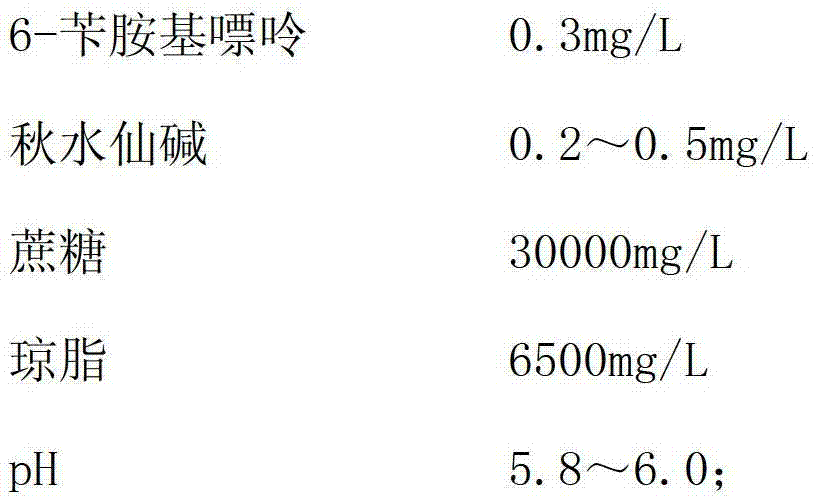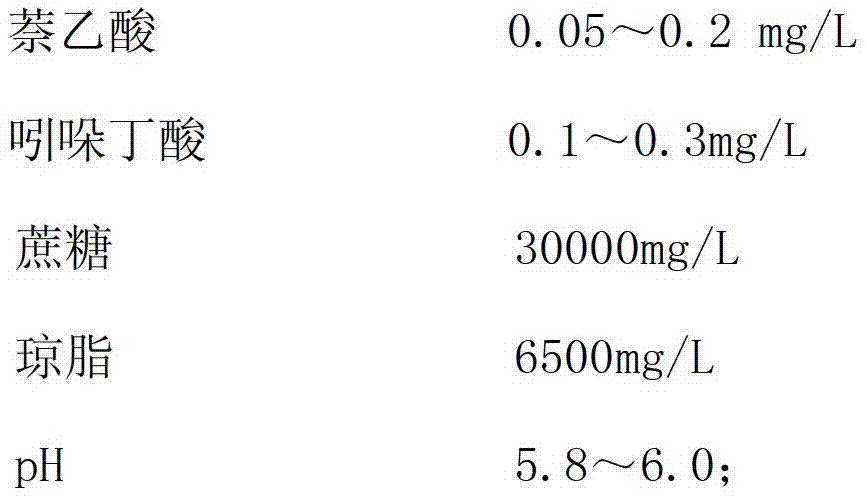Breeding method of gerbera jamesonii homozygote plant
A homozygous and plant technology, applied in the field of breeding of gerbera homozygous plants, can solve the problems of labor-intensive chromosome ploidy identification, low haploid doubling rate, poor rapid reproduction effect, etc. Omit complex procedures and overcome the complex effect of heterozygous state
- Summary
- Abstract
- Description
- Claims
- Application Information
AI Technical Summary
Problems solved by technology
Method used
Image
Examples
Embodiment 1
[0060] A. Selection and pretreatment of explants:
[0061] ① Select the flower buds of F1 generation hybrids whose inflorescence diameter is 3 to 4 cm, and whose tongue-like flowers are 1 to 1.5 cm longer than the sepals;
[0062] ②Low temperature treatment, cut the pedicels of the flower buds, leave the pedicels 4-5cm long, insert them into a bottle with tap water, and put them into a refrigerator at 3°C for low temperature treatment for 7 days;
[0063] ③ Wash the flower buds taken out of the refrigerator with washing powder water first, and then rinse them with clean water. In an ultra-clean environment, disinfect them with 0.1% mercury chloride solution for 15 minutes, and then put them into the following mixed solution for disinfection for 10 minutes. , and then rinsed with sterile water 5 times, each time for 1 min, to obtain sterilized flower buds; the mixed solution is: every 100ml of sodium hypochlorite solution with a mass concentration of 2% was added dropwise 2 d...
Embodiment 2
[0088] Embodiment 2 is the same as Embodiment 1 except for the following operations, and will not be repeated here.
[0089] A. Selection and pretreatment of explants
[0090] ②The temperature of the refrigerator in the low-temperature treatment is 6°C, and the low-temperature treatment is 3 days;
[0091] B, the culture medium of callus induction and sprout differentiation are:
[0092] MS Basic Medium
[0093]
[0094] First culture at a temperature of 27°C in the dark for 15 days, and then switch to a light intensity of 2000lx, a light time of 10h / d, and a temperature of 27°C, and simultaneously carry out callus induction and shoot differentiation culture to explants After germination and differentiation of young shoots larger than 1 cm, within 60 days, the rate of ovule induction into buds reached 28% (28 ovules out of 100 ovules were induced to form buds).
[0095]C. Subculture
[0096] The light intensity of subculture is 2000lx, the temperature is 27°C, the light...
Embodiment 3
[0108] Embodiment 3 is the same as Embodiment 1 except for the following operations, and will not be repeated here.
[0109] A. Selection and pretreatment of explants:
[0110] ②The temperature of the refrigerator in the low-temperature treatment is 4°C, and the low-temperature treatment is performed for 5 days.
[0111] B, the culture medium of callus induction and sprout differentiation are:
[0112] MS Basic Medium
[0113]
[0114] First culture at a temperature of 25°C and in the dark for 15 days, and then switch to the condition of light intensity of 1800lx, light time of 11h / d, and temperature of 25°C, simultaneously carry out callus induction and shoot differentiation culture to explants After germination and differentiation of young shoots larger than 1 cm, within 60 days, the rate of ovule induction into buds reached 36% (36 ovules were induced to buds out of 100 ovules).
[0115] C. Subculture:
[0116] The light intensity of the subculture was 1800lx, the te...
PUM
 Login to View More
Login to View More Abstract
Description
Claims
Application Information
 Login to View More
Login to View More - R&D
- Intellectual Property
- Life Sciences
- Materials
- Tech Scout
- Unparalleled Data Quality
- Higher Quality Content
- 60% Fewer Hallucinations
Browse by: Latest US Patents, China's latest patents, Technical Efficacy Thesaurus, Application Domain, Technology Topic, Popular Technical Reports.
© 2025 PatSnap. All rights reserved.Legal|Privacy policy|Modern Slavery Act Transparency Statement|Sitemap|About US| Contact US: help@patsnap.com



